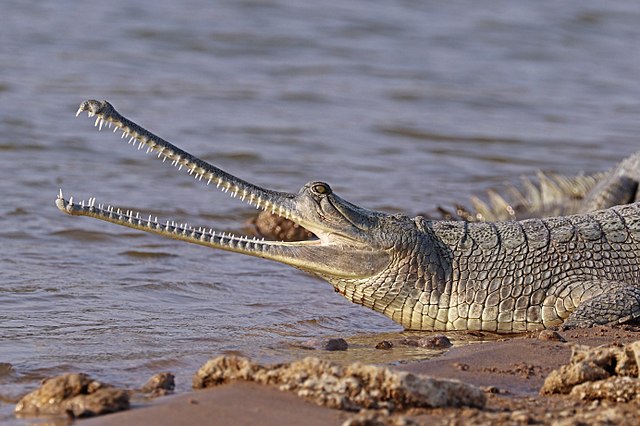The Gharial is a charismatic crocodilian species native to the river ecosystems of India and Nepal, this fish-eating Crocodilian species has faced a dramatic decline in its population numbers in the recent decade due to various threats such as habitat loss, egg poaching, sand mining, etc. It is estimated that about 200 mature Individuals are present in the rivers of India and Nepal. However, not all hope is lost as concentrated conservation efforts by Individuals and Governments are being carried out to revive the species from imminent decline and extinction.
Characteristics
The gharial can be distinguished prominently from other Crocodilian species by its long and slender snout adapted to catching fish, Males can grow up to 18 feet in length making them the largest Crocodilian species in India, they are generally found in deep fast flowing
Major Threats to Gharials
Gharials face an existential crisis in the world fastest growing country in terms of economy, to complement the fast-growing economy of India construction of infrastructure is happening at a massive scale for which demand for sand used in construction has gone up and hence illegal sand mining is taking place in crucial and pristine Gharial habitat to fuel the construction boom, The major sand mining players have formed a nexus and are challenging the local authority while plundering the river ecosystems in their endless lust for profits. Along with Illegal sand mining, river pollution, and egg poaching are a major threat to Gharial’s population as major Industries are dumping untreated effluent into the water which pollutes the river killing all the fish and aquatic species that the Gharial depend upon for food, the lack of food resources is driving the Gharial to places where they can find food but are human-dominated landscapes hence posing a threat to their lives as well as the eggs which they lay on the sandbanks are increasingly being poached for its purported medicinal use, also the draining of rivers and construction of Dams are a major contributors to the population decline of Gharials as they increase the silt content in the rivers which leads to pollution and decrease in Fish source.
Conservation Initiatives
Gharial Conservation Breeding Programme: This program was launched in the 1970s in response to the rapid decline in the numbers of Gharial, hence breeding centers were established where the Gharials could breed and propagate in a safe and clean environment before being released into the wild. The first captive breeding program of Gharials was started in 1980 is Nandankanan Zoological Park in Odisha.
National Gharial Conservation and Management Plan: This program was started by the Indian Government in collaboration with Scientists, NGOs, Conservation organizations, and other wildlife experts. It outlines the comprehensive strategies required to be adopted for Gharial conservation and management to save the species from the brink of extinction, due to this program along with other initiatives the Gharial population has stabilized and is on the rise.
Community-based conservation initiatives (CBCs): Several organizations have launched community-based conservation initiatives that involve the local communities in Gharial conservation including Gharial monitoring, Habitat restoration, public awareness, etc.
Habitat restoration: The Indian Government with several conservation organizations has launched habitat restoration programs to restore degraded habitats and make them viable for the Gharials to live and breed.
Despite the efforts of the Indian Government and many dedicated and motivated organizations and individuals, the population of Gharials is on the rise but inversely the area for Gharial habitat is on the decline due to unsustainable Industrial practices and human encroachment and agriculture, though such initiatives in the long run will be beneficial for the Gharials.
